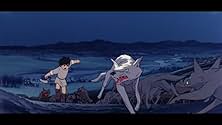Although it was made in 1968, this fascinating animated film feels more like it came out a few years before Nausicaa in the early 1980s; fans of Studio Ghibli will recognize all of its distinctive calling cards. One of these calling cards is the feeling of being totally immersed in an alternate world, which, in this case, is achieved through cultural ambiguity. The odd title, Horus: Prince of the Sun, suggests a pseudo-Egyptian setting, but that couldn't be further from the truth: it is instead vaguely Scandinavian, with its focus on northern villages, but drawing on the culture and mythology of the Ainu, the indigenous people of Hokkaido, Japan's northern island. There are relatively few people, and they are barely surviving given the harsh environment and the evil demon Grunwald, who wants to eliminate humanity; in fact, the isolated village recalls in many ways the post-apocalyptic world of Nausicaa.
While this movie is usually heralded as an auspicious beginning for Japanese anime and Studio Ghibli, I noticed the strong influence of one of its forebears: Lev Atamanov's Snow Queen. In particular, the dark and cold Grunwald is very much like a male version of the Snow Queen, including his appearance. Horus and Hilda recall Kay and Gerda, except that here it is Hilda who is under the spell of the Snow (King). Hilda, like Gerda, is guided by a bird, this time an evil owl. I could go on, but the influence is real, and significant, as acknowledged by Miyazaki. The major difference is that, unlike the later Ghibli films (and Atamanov's Snow Queen, for example), it is the male rather than the female who is the lead.

























